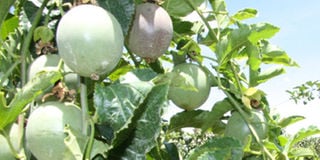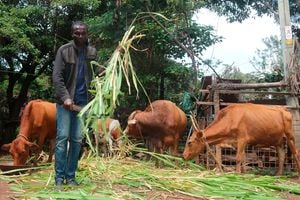
Passion fruit.
Management of passion fruit plants after transplanting ensures healthy growth and high yields. This varies, depending on the growth stage, nutritional needs and overall health of the vines.
Passion fruits require attentive care at every stage of growth, from proper nutrition to managing pests, diseases.
This article is a detailed guide on how to care for passion fruit plants, focusing on their nutrition and cultural needs across different growth stages.
In the early vegetative stage of passion fruit development, rapid root and vine growth occurs after transplanting. Balanced nutrition through top dressing with NPK fertiliser is vital, along with bi-weekly calcium and magnesium foliar sprays.
Proper vine training using a support pole helps guide vines toward a trellis, optimising sunlight exposure and airflow. Key cultural practices include defoliation, where older leaves are removed to redirect nutrients to new shoots, and de-suckering, which eliminates unwanted lateral vines, preventing crowding and promoting productive growth.
Weeding is critical for maintaining a clean growing environment. Weeds compete for nutrients and water. Manual weeding, such as hand-pulling, is preferred to avoid root damage. Equally important is maintaining consistent irrigation during dry periods, as water stress can stunt growth.
As the plant matures and enters the late vegetative stage, vine growth accelerates. Vine training, defoliation and de-suckering remain essential. The application of nitrogen and calcium-rich fertiliser in the fourth month ensures strong leaf development.
Manure can also be used and supplemented with nitrogen and calcium foliar sprays. A balanced NPK foliar fertiliser with trace elements, including magnesium, zinc and boron, should be applied monthly. When applying fertiliser, ensure the soil is moist. Distribute it in a circular pattern approximately 1.5ft from the vine stem.
The flowering and fruiting stages occur six to seventh months after transplanting. Any disruptions, such as pest infestations, diseases or inadequate nutrition can lead to flower abortion and ultimately reduce yields. To support healthy flowering, top dressing with NPK 17:17:17 fertiliser in the sixth month is recommended. After fertiliser application, there should be irrigation, especially if the soil is dry to prevent the loss of fertiliser through volatilisation.
Proper vine management is critical during this phase. Allowing new lateral vines to hang down from the trellis and consistently removing tendrils prevents the plant from becoming overly bushy. Selective pruning of lateral shoots that grow from the main leaders as they extend towards the trellis wire promotes healthy growth.
Light pruning of lateral shoots to 15cm above the ground helps prevent fungal infections by keeping the shoots off the soil.
Vines begin producing fruits between six and eight months after planting, with peak harvests occurring between 13 and 15 months. There are two primary fruiting periods in Kenya – August to December and March to May. It takes 75 to 85 days for the fruits to reach maturity after flowering.
During this stage, maintaining optimal crop nutrition is essential for healthy fruit production. Top-dressing with potassium-rich fertiliser every three months promotes healthy flower and fruit formation.
Foliar sprays containing potassium, boron and calcium should be applied every two weeks to support flowering.
Depending on the soil fertility, apply manure every other three or four months to boost nitrogen and foliar development.







